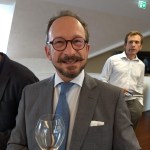
The Tin House in a suburban street in Shepherd’s Bush might not seem like the most salubrious venue for the launch of a leading prestige cuvée champagne from a vintage that many have already marked down as ‘great’ – although only time will show if that epithet is truly applicable. But as we are told at the outset, Krug embraces what it likes to call “rough luxury”.
As recent similar events over the past few years have clearly demonstrated, however obscure and hard to find the venue is, these are experiences worth attending, for Krug is nothing if not generous in sharing comparable or perhaps we should say, contrasting, wines, to give the newly launched fizz some perspective.
Thus, we kicked off with a glass of Grande Cuvée Edition 169 which is based on the 2013 harvest, with 60% of the blend coming from that year. A harvest which head winemaker, Julie Cavil describes as “not really a good vintage in Champagne. It was cold with lots of rain and the last October harvest the region had. There were problems with rot and the resultant wines were very fresh, [rather] acid and lacked elements like ripe yellow fruit.”
But this is where the magic of blending Grande Cuvée comes to the fore. The combination of a total of 146 different wines in the blend, taken from 13 harvests stretching back to 2000, brings balance, depth of flavour and attractively rich expression. “You need individual character in Grande Cuvée and we cultivate the differences, that’s the message we give wine growers, who we but buy grapes from.”
It is on tip top form and a reminder that Grande Cuvée doesn’t need to be based on a fine vintage to shine. In fact, to demonstrate the reverse, Olivier Krug is fond of referencing a vertical, blind tasting of five or so Grande Cuvées based on the years around 2001, where all the tasting room team – and that included him, Cavil and her predecessor Eric Lebel — chose the Grande Cuvée based on 2001 as their favourite. And they did so despite the inclusion of blends based on famed years like 2002 and 1999.
After lingering over Edition 169, as a second warm up wine to the 2008, we have the previously released — and generously bestowed with sunshine – 2006 vintage. It proved to be quite a contrast to the 2008, which I guess was precisely the idea.
Cavil reiterated the point that Lebel had made about the 2006 at the launch back in October 2019. “During the summer of 2006 there were more than 23 days when the temperature was above 30degC, compared to the average for the region of seven.” After the scorching heat of July followed by a wet and rather cloudy August the harvest was saved, as is often the case in Champagne, by sunshine in early September just before picking started.
As Cavil says 2006 – which was her first vintage working with Lebel — produced wines of “great generosity, roundness; greedy wines”, as she puts it. There’s also a noticeable creaminess to the mouthfeel. In Krug parlance – they like to give a short label to each vintage — the ’06 was “capricious indulgence”.
They have named the 2008 “élégance intemporelle” which Cavil translates as “classic beauty” though “timeless elegance” sounds more poetic. Perhaps she is referencing the fact that 2008 was a cool year and a return to the classic northern climate conditions in the region. It was “cool, but with no extremes, ripening took place slowly and steadily with no bursts of heat. And that’s resulted in a wine of great elegance and intensity, that is very well structured. It’s straight and classical.”
In fact, it’s currently on the austere side with an incredible racy, grapefruit intensity that’s hard to get past, even though you can sense the depth and hints of great complexity lurking within. But that will take even more time than the 13 years that have already past to evolve.
It is very much redolent of the 2008 vintage, but, given the startlingly fresh attack — that’s still strongly in evidence returning to the glass more than ten minutes after It’s poured — it’s hard to believe 53% of Pinot Noir in the blend comes mainly from Krug’s vineyards in the Montage de Reims Sud, including Aÿ, Mareuil-sur-Aÿ, Bouzy and Ambonnay. You’d suspect the Pinot crus would be the cooler north facing slopes of Verzy and Verzenay.
I put this to Cavil, but she prefers to highlight the fact there’s more Meunier than Chardonnay in the blend, 25% compared to 22% of the latter, which she says, “Brings tension and citrus notes”, while the Chardonnay “imbues the wine with fruit”.
In the glass beside the 2008 we are poured some Grande Cuvée Edition 164, that is the blend which is based on the 2008 harvest. A fabulous treat, and worth the trip to the Tin House on its own, Cavil brilliantly encapsulates its essence by describing it as “breakfast in a glass, there’s toast, marmalade, coffee and butter all there”.
Krug 2008, RRP £265 (at all major fine wine retailers)









